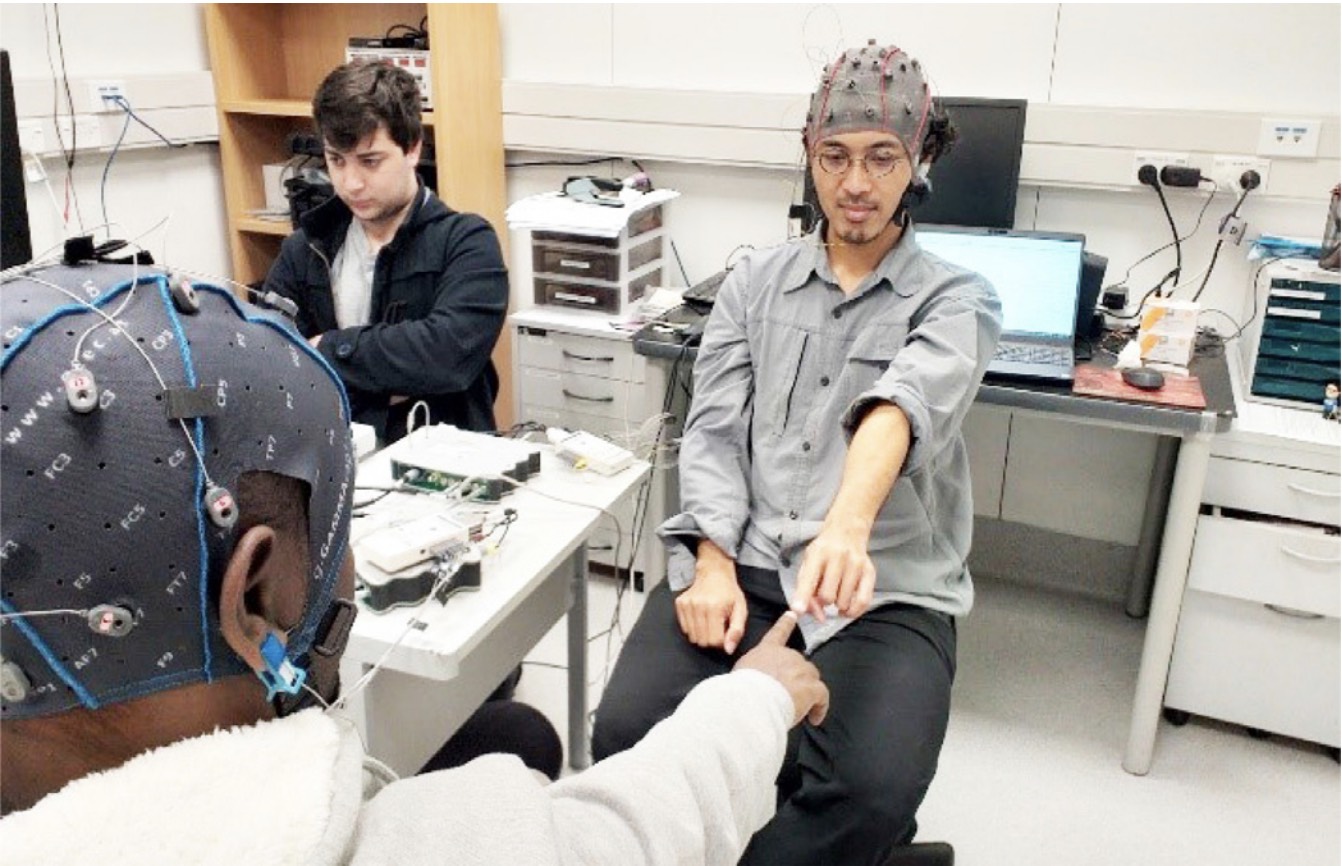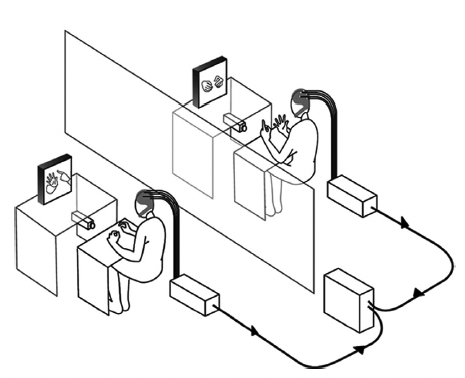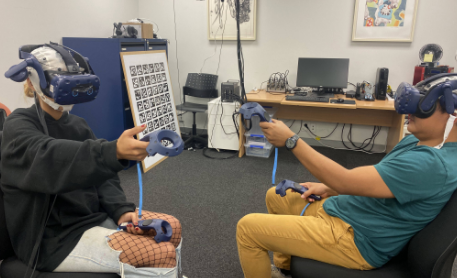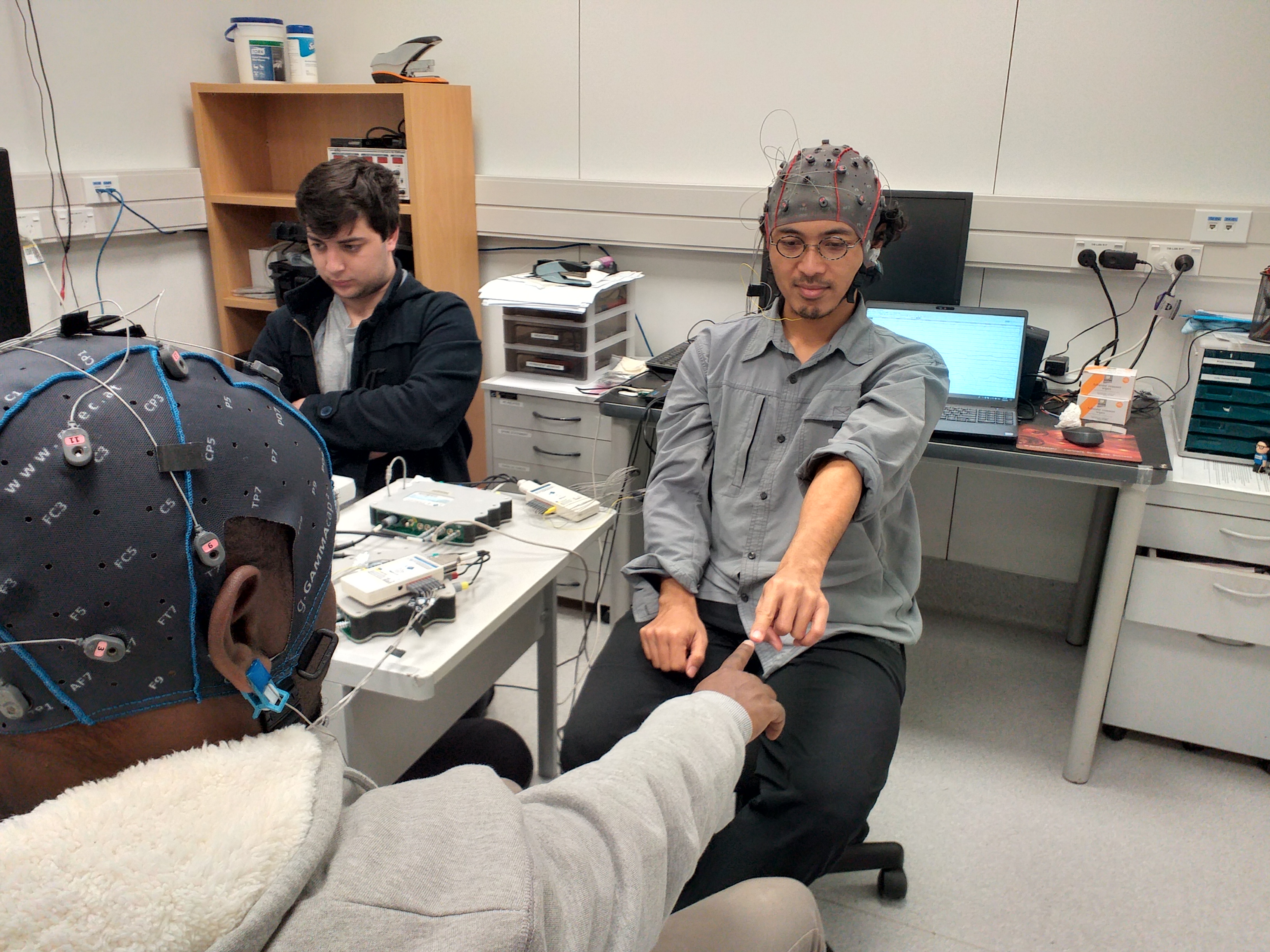Ihshan Gumilar
Ihshan Gumilar
PhD Student
Ihshan was formally trained in psychology. He is a child activist who is concerned about the psychological well-being of children. He puts forward his ideas through writing in newspapers, giving speeches in online media as well as the national television of Indonesia. He is very passionate about learning how the brain communicates and functions in order to understand human psychology and behavior.
He studied in depth about neuropsychology in the lab of Prof. Wim Fias, Department of experimental psychology, Ghent University, Belgium. He is very much interested in collaborating with people from different fields so that innovative ideas can be generated. For his PhD project, Ihshan is investigating how the brains are getting synchronized or connected (hyperscanning) when the owners of the brains are communicating in virtual Reality. Apart from that, he is a person who knows how to entertain his brain by reading novels and playing violin.
Website: https://www.igumilar.com/
Projects
-
Brain Synchronisation in VR
Collaborative Virtual Reality have been the subject of research for nearly three decades now. This has led to a deep understanding of how individuals interact in such environments and some of the factors that impede these interactions. However, despite this knowledge we still do not fully understand how inter-personal interactions in virtual environments are reflected in the physiological domain. This project seeks to answer the question by monitoring neural activity of participants in collaborative virtual environments. We do this by using a technique known as Hyperscanning, which refers to the simultaneous acquisition of neural activity from two or more people. In this project we use Hyperscanning to determine if individuals interacting in a virtual environment exhibit inter-brain synchrony. The goal of this project is to first study the phenomenon of inter-brain synchrony, and then find means of inducing and expediting it by making changes in the virtual environment. This project feeds into the overarching goals of the Empathic Computing Laboratory that seek to bring individuals closer using technology as a vehicle to evoke empathy.
Publications
-

A comparative study on inter-brain synchrony in real and virtual environments using hyperscanning
Ihshan Gumilar, Ekansh Sareen, Reed Bell, Augustus Stone, Ashkan Hayati, Jingwen Mao, Amit Barde, Anubha Gupta, Arindam Dey, Gun Lee, Mark BillinghurstGumilar, I., Sareen, E., Bell, R., Stone, A., Hayati, A., Mao, J., ... & Billinghurst, M. (2021). A comparative study on inter-brain synchrony in real and virtual environments using hyperscanning. Computers & Graphics, 94, 62-75.
@article{gumilar2021comparative,
title={A comparative study on inter-brain synchrony in real and virtual environments using hyperscanning},
author={Gumilar, Ihshan and Sareen, Ekansh and Bell, Reed and Stone, Augustus and Hayati, Ashkan and Mao, Jingwen and Barde, Amit and Gupta, Anubha and Dey, Arindam and Lee, Gun and others},
journal={Computers \& Graphics},
volume={94},
pages={62--75},
year={2021},
publisher={Elsevier}
}Researchers have employed hyperscanning, a technique used to simultaneously record neural activity from multiple participants, in real-world collaborations. However, to the best of our knowledge, there is no study that has used hyperscanning in Virtual Reality (VR). The aims of this study were; firstly, to replicate results of inter-brain synchrony reported in existing literature for a real world task and secondly, to explore whether the inter-brain synchrony could be elicited in a Virtual Environment (VE). This paper reports on three pilot-studies in two different settings (real-world and VR). Paired participants performed two sessions of a finger-pointing exercise separated by a finger-tracking exercise during which their neural activity was simultaneously recorded by electroencephalography (EEG) hardware. By using Phase Locking Value (PLV) analysis, VR was found to induce similar inter-brain synchrony as seen in the real-world. Further, it was observed that the finger-pointing exercise shared the same neurally activated area in both the real-world and VR. Based on these results, we infer that VR can be used to enhance inter-brain synchrony in collaborative tasks carried out in a VE. In particular, we have been able to demonstrate that changing visual perspective in VR is capable of eliciting inter-brain synchrony. This demonstrates that VR could be an exciting platform to explore the phenomena of inter-brain synchrony further and provide a deeper understanding of the neuroscience of human communication. -

Connecting the Brains via Virtual Eyes: Eye-Gaze Directions and Inter-brain Synchrony in VR
Ihshan Gumilar, Amit Barde, Ashkan Hayati, Mark Billinghurst, Gun Lee, Abdul Momin, Charles Averill, Arindam Dey.Gumilar, I., Barde, A., Hayati, A. F., Billinghurst, M., Lee, G., Momin, A., ... & Dey, A. (2021, May). Connecting the Brains via Virtual Eyes: Eye-Gaze Directions and Inter-brain Synchrony in VR. In Extended Abstracts of the 2021 CHI Conference on Human Factors in Computing Systems (pp. 1-7).
@inproceedings{gumilar2021connecting,
title={Connecting the Brains via Virtual Eyes: Eye-Gaze Directions and Inter-brain Synchrony in VR},
author={Gumilar, Ihshan and Barde, Amit and Hayati, Ashkan F and Billinghurst, Mark and Lee, Gun and Momin, Abdul and Averill, Charles and Dey, Arindam},
booktitle={Extended Abstracts of the 2021 CHI Conference on Human Factors in Computing Systems},
pages={1--7},
year={2021}
}Hyperscanning is an emerging method for measuring two or more brains simultaneously. This method allows researchers to simultaneously record neural activity from two or more people. While this method has been extensively implemented over the last five years in the real-world to study inter-brain synchrony, there is little work that has been undertaken in the use of hyperscanning in virtual environments. Preliminary research in the area demonstrates that inter-brain synchrony in virtual environments can be achieved in a mannersimilar to thatseen in the real world. The study described in this paper proposes to further research in the area by studying how non-verbal communication cues in social interactions in virtual environments can afect inter-brain synchrony. In particular, we concentrate on the role eye gaze playsin inter-brain synchrony. The aim of this research is to explore how eye gaze afects inter-brain synchrony between users in a collaborative virtual environment -

A Review of Hyperscanning and Its Use in Virtual Environments
Ihshan Gumilar, Ekansh Sareen, Reed Bell, Augustus Stone, Ashkan Hayati, Jingwen Mao, Amit Barde, Anubha Gupta, Arindam Dey, Gun Lee, Mark BillinghurstBarde, A., Gumilar, I., Hayati, A. F., Dey, A., Lee, G., & Billinghurst, M. (2020, December). A Review of Hyperscanning and Its Use in Virtual Environments. In Informatics (Vol. 7, No. 4, p. 55). Multidisciplinary Digital Publishing Institute.
@inproceedings{barde2020review,
title={A Review of Hyperscanning and Its Use in Virtual Environments},
author={Barde, Amit and Gumilar, Ihshan and Hayati, Ashkan F and Dey, Arindam and Lee, Gun and Billinghurst, Mark},
booktitle={Informatics},
volume={7},
number={4},
pages={55},
year={2020},
organization={Multidisciplinary Digital Publishing Institute}
}Researchers have employed hyperscanning, a technique used to simultaneously record neural activity from multiple participants, in real-world collaborations. However, to the best of our knowledge, there is no study that has used hyperscanning in Virtual Reality (VR). The aims of this study were; firstly, to replicate results of inter-brain synchrony reported in existing literature for a real world task and secondly, to explore whether the inter-brain synchrony could be elicited in a Virtual Environment (VE). This paper reports on three pilot-studies in two different settings (real-world and VR). Paired participants performed two sessions of a finger-pointing exercise separated by a finger-tracking exercise during which their neural activity was simultaneously recorded by electroencephalography (EEG) hardware. By using Phase Locking Value (PLV) analysis, VR was found to induce similar inter-brain synchrony as seen in the real-world. Further, it was observed that the finger-pointing exercise shared the same neurally activated area in both the real-world and VR. Based on these results, we infer that VR can be used to enhance inter-brain synchrony in collaborative tasks carried out in a VE. In particular, we have been able to demonstrate that changing visual perspective in VR is capable of eliciting inter-brain synchrony. This demonstrates that VR could be an exciting platform to explore the phenomena of inter-brain synchrony further and provide a deeper understanding of the neuroscience of human communication. -

Inter-brain Synchrony and Eye Gaze Direction During Collaboration in VR
Ihshan Gumilar , Amit Barde , Prasanth Sasikumar , Mark Billinghurst , Ashkan F. Hayati , Gun Lee , Yuda Munarko , Sanjit Singh , Abdul MominGumilar, I., Barde, A., Sasikumar, P., Billinghurst, M., Hayati, A. F., Lee, G., ... & Momin, A. (2022, April). Inter-brain Synchrony and Eye Gaze Direction During Collaboration in VR. In CHI Conference on Human Factors in Computing Systems Extended Abstracts (pp. 1-7).
@inproceedings{gumilar2022inter,
title={Inter-brain Synchrony and Eye Gaze Direction During Collaboration in VR},
author={Gumilar, Ihshan and Barde, Amit and Sasikumar, Prasanth and Billinghurst, Mark and Hayati, Ashkan F and Lee, Gun and Munarko, Yuda and Singh, Sanjit and Momin, Abdul},
booktitle={CHI Conference on Human Factors in Computing Systems Extended Abstracts},
pages={1--7},
year={2022}
}Brain activity sometimes synchronises when people collaborate together on real world tasks. Understanding this process could to lead to improvements in face to face and remote collaboration. In this paper we report on an experiment exploring the relationship between eye gaze and inter-brain synchrony in Virtual Reality (VR). The experiment recruited pairs who were asked to perform finger-tracking exercises in VR with three different gaze conditions: averted, direct, and natural, while their brain activity was recorded. We found that gaze direction has a significant effect on inter-brain synchrony during collaboration for this task in VR. This shows that representing natural gaze could influence inter-brain synchrony in VR, which may have implications for avatar design for social VR. We discuss implications of our research and possible directions for future work.


